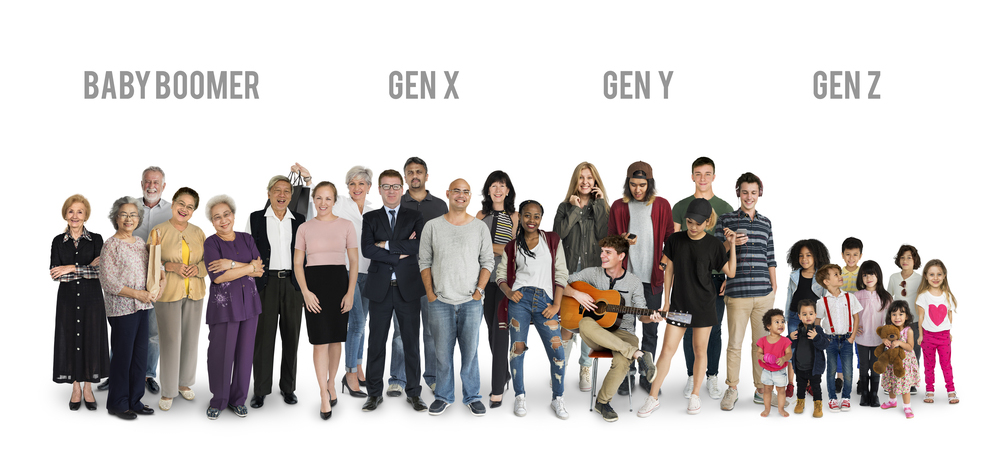Baby Boomers, Gen Xers, Millennials, and Gen Zs, oh my! The workplace has become a “melting pot” of diverse workers from all different age groups, and though some may fear a disconnect among workers, new research finds this is not the case.
Everybody IS Getting Along
Staffing firm Addison Group’s latest report, “Age Is Just a Number: The Truth Behind Generational Stereotypes at Work,” looks at the different age groups comprising the workforce and how each generation is different but similar when it comes to compensation, work/life balance, and the work they do.
The report was compiled using survey data from 1,000 full- and part-time workers. The data revealed that generations work well together, but there are important differences that still exist. Addison Group says it’s these differences that create opportunities for employers to form a more cohesive workforce.
When it comes to work motivation—”what’s in it for me”—all four generations agree that compensation, work/life balance, and meaningful work are the top three driving factors (in that order) that contribute to why they stick with their current employer.
All four generations also get along quite well with each other, but 49% say their employers seem to favor Millennials over the other generations. Although it may appear that employers are playing favorites, the fact that Millennials make up the largest portion of the workforce may have something to do with it.
Additionally, 92% of respondents say they are satisfied with the diversity of age ranges in their workplace, and 86% agree that employees in their age group are respected. It’s nice to see that everyone is getting along and respecting the elders and vice versa, but there is plenty more employers could do to make their workplaces a more united front.
3 Ways to Make Your Entire Workforce Happy
When it comes to making your workers truly happy and cohesive, Addison Group suggests that you act on data, not stereotypes. “We know now that employees across the age spectrum are more alike than they are different. How can workplace leaders act on that information?” asks the report. Addison Group offers a few ways you can create a more unified workforce, as outlined below.
Listen to What Workers Want
As we all know, bias takes many forms, but it is also the result of preconceived notions and stereotypes. Addison Group suggests that instead of basing your thoughts about your workforce on common stereotypes—i.e., Millennials are lazy and entitled—you should be making decisions based on what your employees have to say.
“Rather than internalizing narratives driven by stereotypes, rely on direct feedback from your employees,” suggests the report. “Avoid the urge to parse the responses into different age buckets so you can look for trends or differences.”
In order to make each generation’s workers happy, you must be listening to them to understand their wants and needs. Once you understand what these workers want, you’ll be better equipped to find solutions that cater to the whole organization but that still accommodate each generation separately, as well.
Communicate Changes Consistently
Author Paul J. Meyer once said, “Communication—the human connection—is the key to personal and career success.” And while this may hold true on a personal level, it’s even more true on a business level. Employers that don’t effectively communicate run the risk of losing talent and more, which is why Addison Group ranks communication so high on its list of tips.
In order to make all generations happy, productive, and successful, you need to communicate changes effectively. Case in point: implementing new technology in the workplace. The younger generations are praised for being tech-savvy, which means you can probably get away with deploying new technology and allowing them to pounce on it and learn to use it properly on their own, but for the older generations, there may be some hand-holding involved, which is where communication comes into play.
“As organizations implement new tech-based processes into daily operations, older employees who aren’t as tech fluent might see it as leadership catering to younger workers,” suggests the report. “Meanwhile, if leadership debuts new insurance options with more expansive (and expensive) coverage, younger workers may chalk it up to Baby Boomers in the C-suite looking out for their own needs.”
By clearly communicating company change—whether it’s new technology, new benefits, or a new organizational structure—employers can curb employees’ misgivings right off the bat. Proper communication is also a great way to show employees that these changes are good for not only one particular age group but also the entire organization.
Mentor ALL Generations for Continued Success
“Look for opportunities to connect employees across age groups—not because the generations are fundamentally different but because valuable knowledge and experience come from years in the workplace,” says the report. And mentoring can go both ways!
Using technology as an example, we know that the younger generations are more tech-savvy than the older generations. So, while older workers will have more workplace knowledge, younger workers will be able to provide the guidance older workers will need to succeed as the workplace continues to change to meet new technological implementations.
Mentoring also allows older generations to “pass down” their leadership skills, which will be valuable to Millennial and Gen Z talent, who will eventually fill those vacant roles as Baby Boomers and Gen Xers start retiring. “Knowledge sharing across generational divides provides workplace wisdom to employees so they can find their footing and enjoy fruitful careers,” says Addison Group.
Addison Group leaves us with these parting words: “Today’s working generations are more alike than they are different. If leaders commit to listening to the data and dropping age-biased processes and cultural initiatives, they can earn the respect of their workforces and achieve increased retention of talent across the age spectrum.”
